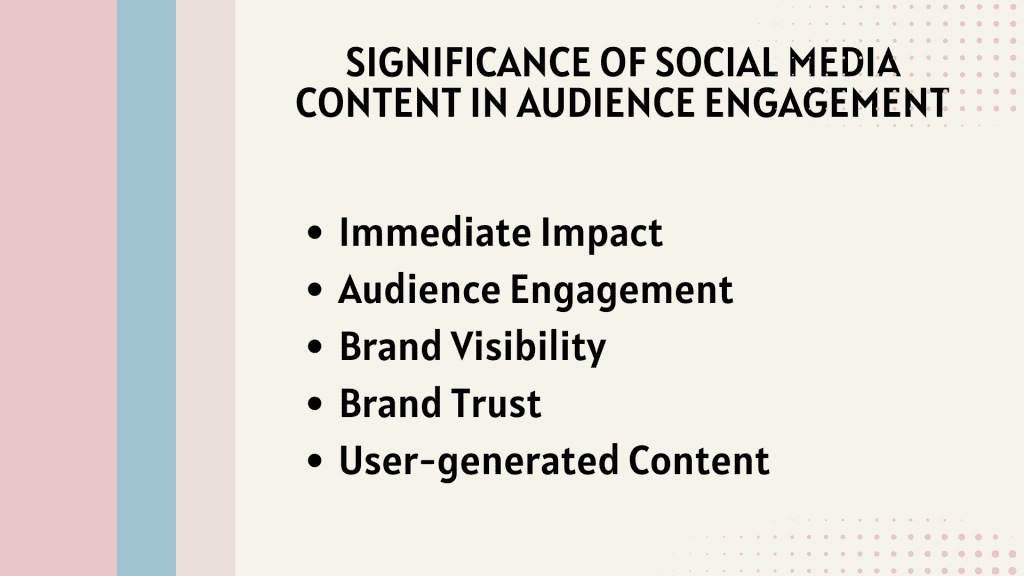In today’s digital age, the importance of social media marketing cannot be overstated. With the vast majority of the world’s population now active on various social media platforms, businesses must harness the potential of these networks to thrive in the competitive digital landscape. In this blog post, we will delve into the pivotal role that content plays in social media marketing, outlining the objectives and strategies to empower your online presence.
Social media marketing is the cornerstone of any effective digital marketing strategy. As more people spend their time on platforms like Facebook, Instagram, Twitter, and LinkedIn, businesses must establish and maintain a strong social media presence to reach their target audience.
In the realm of digital marketing, social media acts as a gateway to connect with your audience, drive traffic to your website, and increase brand visibility. It’s not just about having a presence; it’s about engaging and interacting with your audience effectively.
Content lies at the heart of successful social media marketing. High-quality, engaging content is what captures the attention of your followers and encourages them to interact with your brand. Whether it’s a captivating video, an informative blog post, or an eye-catching infographic, your content strategy is your ticket to social media success.
Your social media content should be tailored to resonate with your target audience’s interests and preferences. This includes sharing valuable information, entertaining content, and solutions to their pain points. By doing so, you not only foster engagement but also build a loyal following that advocates for your brand.
The primary objective of this blog is to provide you with a comprehensive understanding of the pivotal role that content plays in social media marketing. We will explore the various aspects of content creation, optimization, and promotion on social media platforms. By the end of this blog, you will be equipped with actionable insights and strategies to enhance your social media marketing efforts.
Understanding Social Media Content
Social media content is the lifeblood of digital marketing in today’s fast-paced online landscape. It refers to the various forms of media, including text, images, videos, infographics, and more, that are created and shared on social media platforms. This content is specifically tailored to engage and interact with the target audience, foster brand awareness, and drive user engagement.

Significance of Social Media Content in Audience Engagement
The significance of social media content in engaging and attracting audiences cannot be overstated. It serves as a direct channel for brands to connect with their followers, customers, and potential clients. Let’s delve into why social media content is pivotal in today’s digital marketing landscape:
- Immediate Impact: Social media content has the power to make an immediate impression on the audience. It is easily digestible and quickly captures the viewer’s attention.
- Audience Engagement: Effective social media content invites likes, shares, comments, and other forms of engagement, fostering a sense of community around your brand.
- Brand Visibility: Consistent and engaging content helps increase your social media presence, making your brand more visible to a wider audience.
- Brand Trust: High-quality content showcases your expertise and builds trust with your audience, positioning you as a reputable source in your industry.
- User-generated Content: Encouraging user-generated content through your campaigns and interactions amplifies your brand’s reach and authenticity.
Types of Social Media Content
Social media content comes in various forms, each serving a unique purpose in engaging your audience:
- Text: Written content in the form of posts, updates, tweets, and captions.
- Images: Visual content, such as photographs, graphics, and memes, that convey messages and emotions.
- Videos: Dynamic content that can be informative, entertaining, or promotional, delivered through live streaming, stories, or traditional videos.
- Infographics: Visual representations of data and information that are easy to digest and share.
- Audio: Podcasts, voice messages, and audio clips that cater to auditory learners.
- Interactive Content: Polls, quizzes, and contests that encourage participation.
- User-generated Content: Content created by your audience, such as reviews, testimonials, and user-submitted photos.
Incorporating a mix of these content types into your social media strategy helps keep your audience engaged and interested in what your brand has to offer.
Effective Content for Social Media Marketing
To create effective content for social media marketing, you must consider your content strategy, digital marketing goals, and social media presence. Focus on content creation that aligns with your target audience’s preferences, incorporates relevant keywords naturally, and follows current social media trends.
The Power of Compelling Content
In the dynamic realm of digital marketing, the power of compelling content cannot be underestimated. High-quality content serves as the linchpin that drives engagement, fosters conversions and builds a strong online presence. In this section, we will explore the profound impact of quality content on social media marketing and showcase real-life examples of successful content campaigns, all while emphasizing the critical importance of consistency and relevance in content creation.
Driving Engagement and Conversions with High-Quality Content
Engagement: Compelling content is the heart and soul of any successful social media marketing strategy. It captivates your audience’s attention, encourages them to interact with your brand, and ignites conversations. Engaged users are more likely to like, share, comment, and ultimately become advocates for your brand. It’s a ripple effect that begins with exceptional content.
Conversions: Beyond engagement, high-quality content is a conversion catalyst. It educates, persuades, and guides your audience towards taking desired actions, whether it’s signing up for a newsletter, making a purchase, or sharing contact information. Effective content builds trust and credibility, making it easier to turn visitors into loyal customers.
Real-Life Examples of Successful Social Media Content Campaigns
- Dove’s Real Beauty Campaign: Dove’s campaign celebrated real beauty by featuring women of all shapes, sizes, and backgrounds. Their social media content included powerful images and videos that resonated with millions, driving engagement and reinforcing their brand message.
- Airbnb’s #WeAccept Campaign: Airbnb’s campaign responded to global issues by promoting acceptance and diversity. Their content included heartwarming stories and user-generated content, sparking conversations and showcasing their commitment to social values.
- Oreo’s Daily Twist Campaign: Oreo’s campaign celebrated their 100th birthday by posting a daily twist on their iconic cookie. Their creative and consistent content captivated audiences and led to increased brand loyalty and sales.
Consistency and Relevance in Content Creation
- Consistency: Regularly posting high-quality content keeps your audience engaged and returning for more. Consistency builds anticipation and trust, ensuring that your brand remains top-of-mind.
- Relevance: Content must align with your target audience’s interests, needs, and pain points. In-depth research and understanding of your audience’s preferences allow you to create content that resonates deeply and drives meaningful engagement.
Creating Effective Content for Social Media Marketing
Creating content for social media marketing that resonates with your target audience is a key element in achieving success in the digital landscape. To stand out in the crowded social media sphere, it’s essential to follow best practices and employ strategies that captivate, engage, and inspire action. In this section, we’ll explore tips and best practices for crafting content that leaves a lasting impression, the importance of storytelling and emotional appeal, and the role of visuals and multimedia.
1. Tips and Best Practices for Effective Content
- Know Your Audience: Understand your target audience’s demographics, interests, and pain points. Tailor your content to meet their specific needs and preferences.
- Content Strategy: Develop a clear content strategy that aligns with your overall digital marketing goals. Plan your content calendar in advance to maintain consistency.
- Quality Over Quantity: Focus on creating high-quality content that provides value to your audience. One well-crafted post can outperform multiple mediocre ones.
- Keyword Optimization: Integrate relevant keywords, including ‘Content for social media marketing,’ naturally within your content. This helps improve discoverability and SEO.
- Engage and Interact: Encourage audience engagement by asking questions, running polls, and responding promptly to comments and messages. Build a sense of community around your brand.
2. The Importance of Storytelling and Emotional Appeal
- Craft Compelling Stories: People remember stories. Use storytelling techniques to narrate your brand’s journey, customer success stories, or the evolution of your products or services.
- Evoke Emotions: Emotional content resonates deeply with the audience. Whether it’s humour, empathy, or inspiration, tap into emotions that align with your brand and message.
- User-Generated Content: Share user-generated content that showcases real experiences and emotions related to your brand. This builds trust and authenticity.
3. Using Visuals and Multimedia in Content Creation
- Visual Appeal: Incorporate eye-catching visuals, such as images and graphics, to enhance the visual appeal of your content. High-quality images and infographics can convey complex information effectively.
- Video Content: Video is a powerful tool for engagement. Create short videos, live streams, and video stories to convey your message in a dynamic and engaging way.
- Interactive Content: Use interactive elements like quizzes, polls, and interactive infographics to keep your audience engaged and encourage participation.
- Multimedia Posts: Combine various forms of media within a single post, such as a video with captions or an image with a compelling caption. This provides a well-rounded experience.
Content Planning and Strategy
Effective content planning and strategy are at the core of successful social media marketing. Crafting a well-structured plan, aligning it with marketing goals and target audience interests, and utilizing content calendars and management tools are essential for achieving your digital marketing objectives. In this section, we will walk you through the process of content planning and scheduling, emphasizing the role of content calendars, and the importance of alignment with marketing goals and audience interests.
1. The Process of Content Planning and Scheduling
Identify Goals and Objectives: Start by defining your content marketing goals. Are you looking to increase brand awareness, drive website traffic, generate leads, or boost sales? Your goals will shape your content strategy.
Audience Research: Understand your target audience’s demographics, preferences, and pain points. This insight helps you create content that resonates with them.
Keyword Research: Conduct keyword research to discover relevant terms and phrases that can guide your content creation and improve SEO.
Content Creation: Develop high-quality content that addresses your audience’s needs and aligns with your marketing goals. Ensure it provides value and answers their queries.
Content Scheduling: Use a content calendar to plan when and where you will publish your content. This ensures a consistent posting schedule.
2. Role of Content Calendars and Content Management Tools
Content Calendars: A content calendar is a crucial tool for organizing and scheduling your content. It helps you maintain consistency and ensures that your content aligns with your overall strategy. Include the type of content, posting dates, and platforms in your calendar.
Content Management Tools: Utilize content management tools like Buffer, Hootsuite, or Sprout Social to schedule and manage your social media posts efficiently. These tools offer features such as post-scheduling, analytics, and collaboration capabilities.
3. Aligning Content with Marketing Goals and Target Audience Interests
Consistency with Marketing Goals: Every piece of content you create should contribute to your overall marketing goals. If your goal is to increase website traffic, create content that encourages clicks and shares.
Audience-Centric Content: Tailor your content to address the interests and pain points of your target audience. Use their language and speak directly to their needs.
Embrace Diversity: Diversify your content types to cater to different preferences within your audience. Use text, images, videos, infographics, and interactive content as needed.
Addressing Keywords: Incorporate relevant keywords naturally within your content to improve SEO and enhance discoverability.
4. Measuring and Adapting
Monitor the performance of your content using social media analytics tools. Track metrics like engagement rates, click-through rates, and conversion rates to assess the effectiveness of your content.
Use the insights gained from analytics to adapt your content strategy. If certain types of content are performing exceptionally well, consider creating more of them. Conversely, if some content is underperforming, analyze why and make necessary adjustments.
Conclusion
The power of social media content cannot be underestimated in today’s digital age. It serves as the lifeblood of successful marketing strategies, providing a direct channel to engage with your target audience, build brand awareness, and drive business growth. By creating high-quality, relevant, and consistent content that resonates with your followers, you can establish a strong online presence, foster meaningful relationships, and ultimately, achieve marketing success.
However, it’s essential to remember that the social media landscape is constantly evolving. To stay ahead in the game, businesses must adapt to changing trends, algorithms, and audience preferences. Continuous innovation, data-driven insights, and a commitment to delivering value to your audience will be the keys to harnessing the full potential of social media content for your marketing endeavors.
So, as you embark on your social media marketing journey, keep in mind that content is not just a tool but the driving force behind your success. Embrace its power, stay authentic, and watch as it propels your brand to new heights in the ever-expanding digital realm.
FAQs
What are effective social media content ideas?
Effective social media content ideas include storytelling, behind-the-scenes looks, user-generated content, polls and surveys, tutorials, and interactive posts like quizzes or challenges. Content should align with your brand and resonate with your target audience.
How can I optimize my social media posts?
Optimize social media posts by using relevant hashtags, engaging visuals, compelling captions, and posting at optimal times for your audience. Consistency and audience interaction are key to maximizing post visibility and engagement.
What are the strategies for social media marketing?
Effective social media marketing strategies involve defining clear goals, understanding your target audience, creating valuable content, utilizing paid advertising, engaging with followers, and analyzing metrics for continuous improvement.
How do I create shareable social media content?
Create shareable content by focusing on emotional triggers, using storytelling, incorporating humor, leveraging trends, and crafting visually appealing, informative, or entertaining posts. Encourage sharing with incentives like contests or giveaways.
How can I boost social media engagement?
Boost engagement by posting consistently, responding to comments and messages promptly, running interactive campaigns, collaborating with influencers, and using analytics to refine your content strategy.
How do I measure social media ROI?
Measure social media ROI by tracking key metrics such as engagement, leads, conversions, and revenue generated from social media efforts. Use tools like Google Analytics, social media analytics, and attribution modeling to assess ROI accurately.
What are the latest social media trends?
Recent social media trends include short-form video content, live streaming, ephemeral content (stories), augmented reality filters, social commerce, and the continued rise of niche communities.
What are the best social media management tools?
Popular social media management tools include Hootsuite, Buffer, Sprout Social, and HubSpot. These platforms offer features for scheduling, analytics, content planning, and team collaboration.
How do I plan content for social media?
Plan social media content by setting goals, researching your audience, creating a content calendar, diversifying content types, and aligning content with your brand’s voice and values. Regularly review and adapt your plan based on performance data.






